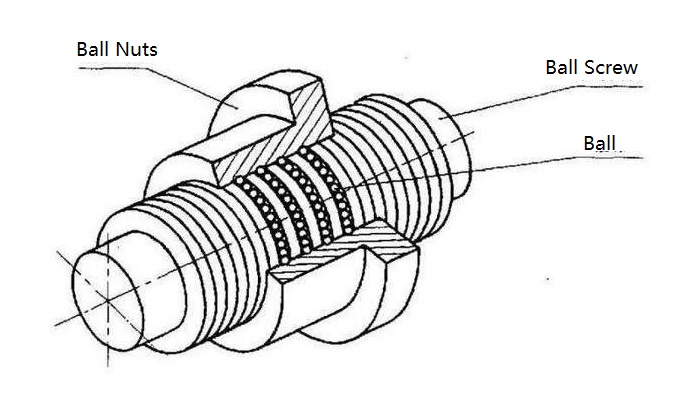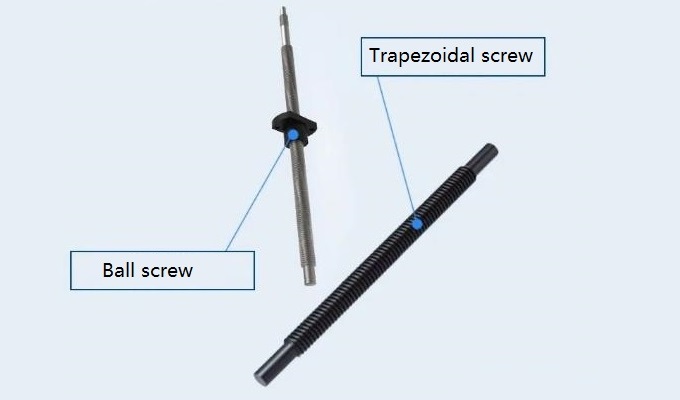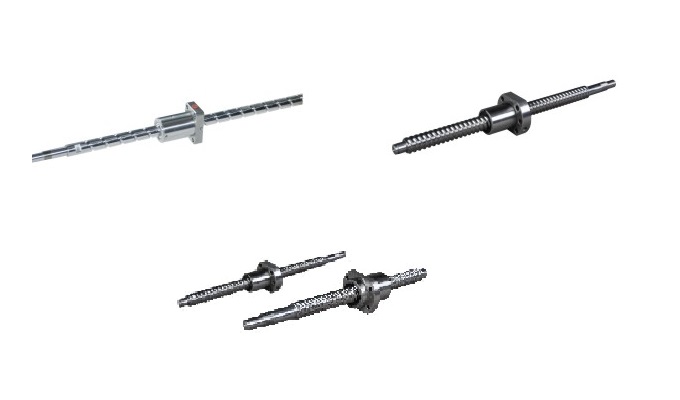Excessive Clearance
1. Lack of preload or insufficient preload
Cause: When a ball screw lacks preload and is vertically positioned, the weight of the nut can cause it to rotate and slide downward.
Analysis: In the case of a screw without preload, significant backlash will be present, limiting its use to machines with lower operational resistance. However, positional accuracy may not be a critical concern in such applications.
Solution: Applying proper preload to the ball screw can reduce or eliminate excessive clearance. Preload can be achieved through methods such as axial preloading or using double nuts with a spacer.
2. Excessive Torsional Displacement
Cause: Improper heat treatment, resulting in inadequate hardening, uneven hardness distribution, or excessively soft material. The standard hardness for steel balls, nuts, and screws is typically HRC 62-66, HRC 58-62, and HRC 56-62, respectively.
Analysis: Inadequate design, such as excessive aspect ratio (length-to-diameter ratio) of the screw. A smaller aspect ratio leads to higher rigidity. The aspect ratio should ideally be below 60 to prevent the screw from sagging due to its own weight.
Solution: Single-side support, which provides lower rigidity, should be avoided whenever possible in the design of ball screws.Single-side support, which provides lower rigidity, should be avoided whenever possible in the design of ball screws.
3. Insufficient Rigidity
Cause: Inadequate structural design or material selection
Analysis: Insufficient rigidity may arise from factors such as improper screw diameter or aspect ratio, unsuitable material selection, or inadequate support. These issues can lead to unwanted deflection and decreased performance of the ball screw system.
Solution: Careful consideration of the structural design, appropriate material selection, and ensuring adequate support are essential to enhance the rigidity of ball screws and optimize their performance.
4. Improper Bearing Selection
Cause: Inadequate bearing choice
Analysis: Ball screws typically require angular contact bearings, especially those designed for high-pressure angles. Standard deep groove ball bearings generate axial clearance when subjected to axial loads, making them unsuitable for ball screw applications.
Solution: Select angular contact bearings, particularly those designed for high-pressure angles, to ensure optimal performance and eliminate axial clearance.
5. Improper Bearing Installation
Cause: Inaccurate fitting of bearings to the ball screw
Analysis: Poor alignment between the bearing and ball screw can result in axial clearance, often caused by excessively long or short screw shoulders.
Lack of perpendicularity between the bearing contact surface and the V-shaped axis of the lock nut or inadequate parallelism between the lock nut faces in both directions can cause bearing tilting.
The V-shaped teeth on the screw shoulder and the bearing contact surface should be machined simultaneously to ensure perpendicularity, preferably through grinding.
Using two lock nuts with spring washers can prevent loosening during operation.
Solution: Ensure precise alignment and secure fitting of bearings to the ball screw, maintaining proper perpendicularity and parallelism to eliminate clearance.
6. Insufficient Rigidity of Nut Seat or Bearing Seat
Cause: Lack of rigidity in the nut seat or bearing seat
Analysis: Inadequate rigidity in these components can cause deflection due to the weight of the parts or machine load.
Solution: Enhance the rigidity of the nut seat or bearing seat to prevent deflection, ensuring stable performance.
7. Component loosening due to vibration or lack of locking pins
Cause: Vibrations or the absence of secure locking pins can result in the loosening of components.
Analysis: Insufficient fixation can lead to movement and instability, affecting the overall performance of the system.
Solution: Replace spring pins with solid pins to ensure proper positioning and prevent component loosening caused by vibration.
8. Nut fixing screws loosening without spring washers, inadequate tightening of nut fixing screws
Cause: The loosening of nut fixing screws can occur due to the use of excessively long screws or shallow screw holes in the nut seat, which hinders proper tightening. Additionally, vibrations or the absence of spring washers can contribute to the problem.
Analysis: Inadequate tightening compromises stability and the ability to bear loads, resulting in performance issues.
Solution: To address this issue, it is important to verify the correct screw length and ensure proper engagement with the screw holes in the nut seat for secure fastening. It is also crucial to use spring washers and ensure proper engagement of the nut fixing screws to prevent loosening caused by vibrations.
9. Surface Parallelism or Flatness Exceeding Tolerance in Support Seats
Cause: The surface parallelism or flatness of support seats exceeding the specified tolerance range.
Analysis: When the mating surfaces are not within the specified tolerance, it can lead to reduced reproducibility and precision during table movement.
Solution: Use thin shims between the support seats and the machine body to achieve proper adjustment and align the mating surfaces within the required tolerance range.
10. Improper Combination of Motor and Ball Screw
Cause: Inadequate coupling between the motor and ball screw can result in rotational deviation and improper power transmission.
Analysis: Improper coupling can lead to inefficient operation, increased wear and tear, and reduced system performance.
Solution:
Ensure a secure and rigid coupling between the motor and ball screw to minimize rotational deviation.
Select appropriate coupling mechanisms, such as gears or rigid drive structures, to ensure reliable power transmission.
Check for proper fitting and tightness of keys, keyways, and hubs to prevent any gaps or misalignment between these components.
Awkward Motion
1. Problems with screw processing
(1) Cause: Rough surface of the screw or nut thread.
Analysis: A rough surface increases friction and wear, reducing the smoothness and precision of the screw.
Solution: Use appropriate machining techniques and tools to ensure a smooth surface finish for the screw and nut.
(2) Cause: Exceeding the tolerance range of roundness for steel balls, screw, or nut.
Analysis: Deviations in roundness can lead to uneven force distribution on the steel balls, affecting the rolling performance and precision.
Solution: Control the machining process to ensure that the roundness of steel balls, screw, and nut is within the specified tolerance.
(3) Cause: Errors in thread lead or pitch diameter exceeding the tolerance range.
Analysis: Errors in thread lead or pitch diameter can affect the stability and precision of rolling.
Solution: Strictly control the machining quality of the screw and nut to ensure that the thread lead and pitch diameter are within the tolerance range.
(4) Cause: Improper assembly of the return tube.
Analysis: Incorrect assembly of the return tube can cause damage, indentation, or breakage, resulting in abnormal movement of the steel balls and potential surface damage to the screw or nut threads.
Solution: Follow proper assembly procedures to ensure the correct installation and fastening of the return tube.
(5) Cause: Inconsistent sizes or hardness of steel balls.
Analysis: Uneven sizes or hardness variations in steel balls can lead to imbalanced rolling and instability.
Solution: Select steel balls with uniform quality and meet the specified requirements, and perform appropriate hardness testing and screening.
2. Foreign objects entering the steel ball track
(1) Cause: Packaging materials obstructing the steel ball track.
Analysis: Improper packaging or arrangement of materials during shipment can obstruct the steel ball track, causing the steel balls to slide instead of rolling properly or even get stuck.
Solution: Follow proper packaging procedures to ensure that materials and rust-proof bags do not obstruct the steel ball track.
(2) Cause: Machining chips entering the track.
Analysis: Without the installation of scrapers on the screw, the accumulation of machining chips or dust can obstruct the steel ball track, resulting in poor smoothness, reduced precision, and shortened lifespan.
Solution: Install suitable scrapers on the screw to remove machining chips and dust, ensuring smooth operation of the steel ball track.
3. Overtravel
Cause: Overtravel leads to damage, indentation, or breakage of the return tube, preventing the steel balls from moving properly. Under such harsh operating conditions, it can potentially cause surface peeling on the screw or nut thread. Overtravel can occur due to machine settings, failure of limit switches, or collisions. To prevent further damage to the screw, it is necessary to have the roller screw inspected and repaired by the manufacturer before reinstalling.
4. Damage to the return tube
Cause: Severe impact during installation of the return tube.
Analysis: Improper installation can cause indentation or breakage of the return tube, leading to the same issues mentioned above.
Solution: Handle the return tube with care during installation, avoiding severe impacts and damage.
5. Eccentricity
Cause: Non-concentric alignment between the nut seat and bearing seat.
Analysis: When the eccentricity between the two is too large, it can cause bending or eccentricity in the screw. Even when the bending of the screw is not significant, abnormal wear continues to occur, rapidly reducing the precision of the screw. Higher eccentricity precision requirements are needed as the preset preload of the nut increases.
Solution: Ensure proper alignment and concentricity between the nut seat and bearing seat to avoid excessive eccentricity and abnormal loads.
6. Improper coupling of the nut and nut seat
Cause: Tilted or eccentric installation of the nut can result in abnormal loads.
Analysis: When the nut is installed with tilt or eccentricity, it creates uneven forces and misalignment, leading to abnormal loads during operation. This can cause instability in the motor's voltage output.
Solution: Ensure proper alignment and concentricity between the nut and nut seat during installation to avoid tilting or eccentricity. Use appropriate fastening techniques to secure the nut in the correct position.
7. Damage to the ball screw during handling
Cause: Mishandling during transportation or handling.
Analysis: Rough handling or improper packaging of the ball screw can result in physical damage, such as bending or impact, leading to performance issues or structural damage.
Solution: Handle the ball screw with care during transportation and ensure proper packaging to protect it from external forces. Follow appropriate handling procedures to prevent any potential damage.
Disintegrate
1. Ball fracture
Cause: Balls used in various applications are typically made of chrome-molybdenum steel. In order to fracture a ball with a diameter of 3.175mm (1/8 inch), a force ranging from approximately 1400kg (3080 pounds) to 1600kg (3520 pounds) is required. Thermal stresses can occur due to significant temperature variations during operation, whether the system is lubricated or dry. These thermal stresses can ultimately lead to ball fracture and result in damage to the nut or screw groove. Therefore, the design process should consider lubrication replenishment. If an automatic lubrication system is not feasible, a maintenance manual should include a plan for lubrication replenishment.
Analysis: The use of chrome-molybdenum steel balls makes them susceptible to fracture under specific force requirements. Moreover, the presence of significant temperature differences during operation can create thermal stresses, further increasing the risk of ball fracture. Insufficient lubrication replenishment can exacerbate this issue.
Solution: To mitigate ball fracture, it is essential to ensure proper lubrication replenishment. During the design phase, consideration should be given to incorporating an automatic lubrication system. If this is not possible, a maintenance manual should outline a comprehensive plan for lubrication replenishment to minimize thermal stresses and prevent ball breakage.
2. Return tube damage or fracture
Cause: Overtravel of the nut or impact on the return tube can result in dents or fractures. These obstructions disrupt the proper path of ball circulation, causing them to slide instead of roll and leading to failure of the return tube.
Solution: To prevent return tube damage, it is essential to limit the nut's travel range and minimize impacts on the return tube. This can be achieved through proper system design and incorporating safeguards. Regular inspections and maintenance should be conducted to promptly identify and address any dents or fractures, ensuring smooth ball circulation and preventing further damage.
3. Fracture of the ball screw shoulder
Cause: The fracture of the ball screw shoulder can be attributed to the following factors:
(1) Improper design: The presence of sharp angles in the screw shoulder leads to localized stress concentration, increasing the risk of fracture. It is essential to design the screw shoulder with smooth contours to mitigate stress concentration.
(2) Bending of the screw journal: Inadequate perpendicularity between the bearing contact surface and the axis of the V-shaped teeth on the locking nut, or poor parallelism between the mating faces of the locking nuts, can result in bending or fracture of the screw shoulder. The deviation of the screw shoulder should be limited to 0.01mm (0.004 inches) before and after tightening the locking nut to prevent damage.
(3) Radial force or cyclic stress: Eccentricity during screw installation introduces abnormal alternating shear stress, causing premature damage to the ball screw shoulder.
Analysis: Improper design with sharp angles increases stress concentration, compromising the strength of the screw shoulder. Poor perpendicularity or parallelism can lead to bending or fracture of the screw shoulder. Eccentricity during installation generates abnormal cyclic stress, further exacerbating the risk of damage.
Solution: To address the fracture of the ball screw shoulder, the following steps should be taken:
(1) Ensure proper design: Avoid sharp angles in the screw shoulder design to minimize stress concentration and enhance strength.
(2) Ensure correct perpendicularity and parallelism: Maintain proper alignment between the bearing contact surface and the axis of the V-shaped teeth on the locking nut, as well as parallelism between the mating faces of the locking nuts. Limit the deviation of the screw shoulder to 0.01mm (0.004 inches) before and after tightening the locking nut.
(3) Mitigate radial force and cyclic stress: Pay attention to the installation process, ensuring that eccentricity is minimized to reduce abnormal alternating shear stress on the ball screw.
By implementing these measures, the risk of ball screw shoulder fracture can be minimized, enhancing the overall performance and reliability of the system.
By understanding the causes and analysis of common issues with ball screws, we can take appropriate measures to prevent and address these problems. This ensures the smooth operation of the ball screw and improves the stability and efficiency of the mechanical system, providing strong support for industrial production. If you have any further questions about ball screws, feel free to contact our experts at Yiheda for assistance.





